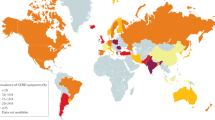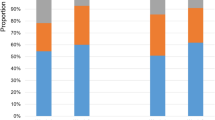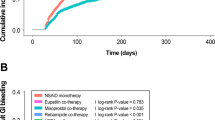Abstract
Patients who are unresponsive to 4–8 weeks' treatment with PPIs twice daily might have so-called refractory GERD. The first investigation these patients should undergo is upper endoscopy to exclude a diagnosis of peptic ulcer disease or cancer and identify the presence of esophagitis. The presence of esophagitis in these patients is suggestive of a pill-induced injury, an autoimmune skin disease involving the esophagus, eosinophilic esophagitis or, less likely, a hypersecretory syndrome or a genotype that confers altered metabolism of PPIs. Refractory reflux syndromes associated with normal endoscopy findings are more problematic to diagnose and further testing may be required, including prolonged 48 h pH testing, impedance measurements (for nonacid reflux), esophageal manometry and gastric function tests. For patients with refractory GERD who do not have esophagitis, possible etiologies include nocturnal gastric acid breakthrough, nonacid GER, missed GER or other diseases such as achalasia, gastroparesis or functional heartburn.
Key Points
-
Approximately 25% of patients who have reflux symptoms fail to respond to twice-daily PPI treatment for 4–8 weeks; these patients are said to have 'refractory GERD'
-
The first test to perform in patients with refractory GERD is upper endoscopy, primarily to assess the presence or absence of esophagitis and other gastric pathology
-
Patients who have esophagitis most commonly have pill-induced injury, autoimmune skin disease associated with esophageal involvement, or eosinophilic esophagitis
-
Those patients who do not have esophagitis are more problematic to manage and have to undergo further tests, including prolonged pH monitoring, impedance testing for nonacid gastroesophageal reflux (GER), esophageal manometry or gastric function testing
-
Patients with refractory GERD without esophagitis might have nocturnal acid breakthrough, nonacid GER or missed acid GER, functional heartburn, or another disease such as achalasia or gastroparesis
This is a preview of subscription content, access via your institution
Access options
Subscribe to this journal
Receive 12 print issues and online access
$209.00 per year
only $17.42 per issue
Buy this article
- Purchase on Springer Link
- Instant access to full article PDF
Prices may be subject to local taxes which are calculated during checkout

Similar content being viewed by others
References
Bardham KD (1995) The role of proton pump inhibitors in the treatment of gastro-oesophageal reflux disease. Aliment Pharmacol Ther 9: 15–25
Barrison AF et al. (2001) Patterns of proton pump inhibitors in clinical practice. Am J Med 111: 469–473
Fass R et al. (2006) Treatment of patients with persistent heartburn symptoms: a double-blind randomized trial. Clin Gastroenterol Hepatol 4: 50–60
Martinez SD et al. (2003) Non-erosive reflux disease (NERD), acid reflux and symptom patterns. Aliment Pharmacol Ther 17: 537–545
Charbel S et al. (2005) The role of esophageal pH monitoring in symptomatic patients on PPI therapy. Am J Gastroenterol 100: 283–289
Pandolfino JE et al. (2003) Ambulatory esophageal pH monitoring using a wireless technique. Am J Gastroenterol 98: 545–550
Kikendall JW (2004) Pill-induced esophageal injury. In The Esophagus, edn 4, 572–584 (Eds Castell DO and Richter JE) Philadelphia: Lippincott Williams and Wilkins
Abid S et al. (2005) Pill-induced esophageal injury: endoscopic features and clinical outcomes. Endoscopy 37: 470–474
Wise JL and Murray JA (2002) Esophageal manifestations of dermatologic disease. Curr Gastroenterol Rep 4: 205–212
Keate RF et al. (2003) Lichen planus: report of three patients treated with oral tacrolimus or intraesophageal corticosteroid injection or both. Dis Esophagus 16: 47–53
Miller LS et al. (1990) Reflux esophagitis in patients with the Zollinger-Ellison syndrome. Gastroenterology 98: 341–346
Hirschowitz BI et al. (2004) Risk factors for esophagitis in extreme acid hypersecretion with and without Zollinger-Ellison syndrome. Clin Gastroenterol Hepatol 2: 220–229
Furuta T et al. (2002) Effect of the cytochrome P4502C19 genotypic differences on cure rates for gastroesophageal reflux disease by lansoprazole. Clin Pharmacol Ther 72: 453–460
Schwab M et al. (2005) Esomeprazole-induced healing of gastroesophageal reflux disease is unrelated to the genotype of CYP2C19: Evidence from clinical and pharmacokinetic data. Clin Pharmacol Ther 78: 627–634
Fox VL et al. (2002) Eosinophilic esophagitis: it's not just kids stuff. Gastrointest Endosc 56: 260–270
Potter JW et al. (2005) Eosinophilic esophagitis in adults: an emerging problem with unique esophageal features. Gastrointest Endosc 59: 355–361
Desai TK et al. (2005) Association of eosinophilic inflammation with esophageal food impaction. Gastrointest Endosc 61: 795–801
Gonsalves N et al. (2006) Histopathologic variability and endoscopic correlation in adults with eosinophilic esophagitis. Gastrointest Endosc 64: 113–119
Mishra A et al. (2001) An etiological role for aeroallergens and eosinophils in experimental esophagitis. J Clin Invest 107: 83–90
Morrow JB et al. (2001) The ringed esophagus: histological features of GERD. Am J Gastroenterol 96: 984–989
Ngo P et al. (2006) Eosinophils in the esophagus—peptic or allergic eosinophilic esophagitis? Case series of three patients with esophageal eosinophilia. Am J Gastroenterol 101: 1666–1670
Straumann A et al. (2003) Natural history of primary eosinophilic esophagitis: a follow-up of 30 adult patients for up to 11.5 years. Gastroenterology 125: 1660–1669
Teitelbaum J et al. (2002) Eosinophilic esophagitis in children: immunopathological analysis and response to fluticasone propionate. Gastroenterology 122: 1216–1225
Konikoff MR et al. (2006) A randomized, double-blind, placebo-controlled trial of fluticasone propionate for pediatric eosinophilic esophagitis. Gastroenterology 131: 1381–1391
Peghini PL et al. (1998) Ranitidine controls nocturnal gastric acid breakthrough on omeprazole: a controlled study in normal subjects. Gastroenterology 115: 1335–1339
Fackler WK et al. (2002) Long-term effect of H2RA therapy on nocturnal gastric acid breakthrough. Gastroenterology 122: 625–632
Wilder-Smith CH et al. (1990) Tolerance to oral H2-receptor antagonists. Dig Dis Sci 35: 976–983
Sifrim D et al. (2001) Acid, non-acid, and gas reflux in patients with gastro-esophageal reflux disease during ambulatory 24-hour pH-impedance recordings. Gastroenterology 120: 1588–1598
Vaezi MF et al. (1994) Validation studies of Bilitec 2000: an ambulatory duodenogastric reflux monitoring system. Am J Physiol 267: G1050–G1075
Koek GH et al. (2001) The role of acid and duodenal gastroesophageal reflux in symptomatic GERD. Am J Gastroenterol 96: 2033–2040
Marshall RE et al. (1997) The relationship between acid and bile reflux and symptoms in gastro-oesophageal reflux disease. Gut 40: 182–187
Zerbib F et al. (2006) Esophageal pH-impedance monitoring and symptom analysis in GERD: a study in patients off and on therapy. Am J Gastroenterol 101: 1956–1963
Mainie I et al. (2006) Acid and non-acid reflux in patients with persistent symptoms despite acid suppressive therapy: a multicenter study using ambulatory impedance-pH monitoring. Gut 55: 1398–1402
Koek GH et al. (2003) Effect of the GABAB agonist baclofen in patients with symptoms and DGE reflux refractory to proton pump inhibitors. Gut 52: 1397–1402
Fletcher J et al. (2004) Studies of acid exposure immediately above the gastro-oesophageal squamocolumnar junction: evidence of stat segment reflux. Gut 53: 168–173
Galmiche JP et al. (2006) Functional esophageal disorder. Gastroenterology 130: 1459–1465
Smout AJPM (1997) Endoscopy-negative acid reflux disease. Aliment Pharmacol Ther 11 (Suppl 2): 81–85
Fass R and Tougas G (2002) Functional heartburn: the stimulus, the pain and the brain. Gut 51: 885–892
Mayer EA and Gebhart GF (1994) Basic and clinical aspects of visceral hyperalgesia. Gastroenterology 107: 271–293
Dhir R and Richter JE (2004) Erythromycin in the short- and long-term control of dyspepsia symptoms in patients with gastroparesis. J Clin Gastroenterol 38: 237–242
Acknowledgements
Désirée Lie, University of California, Irvine, CA, is the author of and is solely responsible for the content of the learning objectives, questions and answers of the Medscape-accredited continuing medical education activity associated with this article.
Author information
Authors and Affiliations
Ethics declarations
Competing interests
Joel E Richter is a member of speakers' bureaus for Astra-Zeneca and TAP.
Rights and permissions
About this article
Cite this article
Richter, J. How to manage refractory GERD. Nat Rev Gastroenterol Hepatol 4, 658–664 (2007). https://doi.org/10.1038/ncpgasthep0979
Received:
Accepted:
Issue Date:
DOI: https://doi.org/10.1038/ncpgasthep0979
This article is cited by
-
Refractory Heartburn: A Challenging Problem in Clinical Practice
Digestive Diseases and Sciences (2018)
-
The Proton Pump Inhibitor Non-Responder: A Clinical Conundrum
Clinical and Translational Gastroenterology (2015)
-
Discussing the influence of electrode location in the result of esophageal prolonged pH monitoring
BMC Gastroenterology (2014)
-
New Approaches to Management of PPI-Refractory Gastroesophageal Reflux Disease
Current Treatment Options in Gastroenterology (2014)
-
The Value of Early Wireless Esophageal pH Monitoring in Diagnosing Functional Heartburn in Refractory Gastroesophageal Reflux Disease
Digestive Diseases and Sciences (2013)



